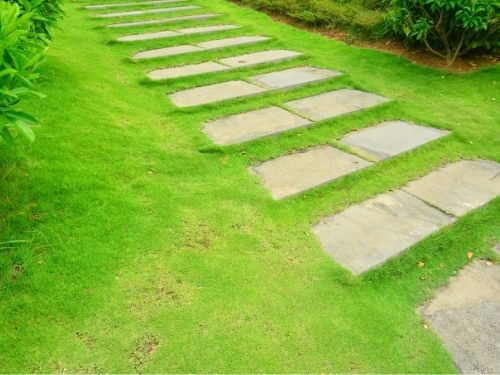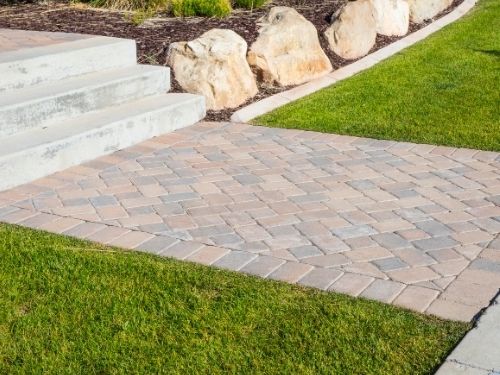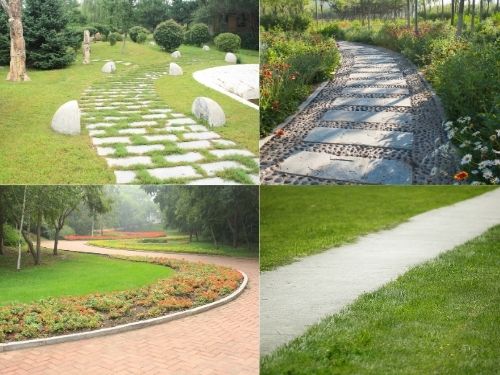Paths and sidewalks allow you to easily reach the house, as well as get to the most frequently used parts of your property. These walkways should match the style of the garden and the building. In this article we’ll show you how to plan and design new pathways in your landscape.
Garden sidewalks not only connect different areas of the plot, but also have a decorative function and divide the space into smaller sectors. If properly laid out, they allow for good organization of the area in front of the house and create a comfortable and pleasant environment. They can emphasize the landscape of the garden and complement the style of the building. In this article you’ll find out how euro paver, gravel, concrete, pebble or brick garden paths can transform your garden, which materials are the most durable and practical, and how to plan and design sidewalks and walkways in such a way as to minimize landscape disturbance.
 How To Design Perfect Sidewalks and Garden Pathways?
How To Design Perfect Sidewalks and Garden Pathways?
Paths in the garden should not only be functional, but also decorative and aesthetically pleasing. When designing garden paths, you should make sure that they blend in nicely with the surroundings and plan them well so they are wide enough for two people to walk together comfortably. In geometric-style gardens, straight walkways look best, and in naturalistic gardens, surfaces with soft curves of various widths will look better.
Garden sidewalks should be durable, frost-resistant and non-slip. Various materials can be used to build them, and it does not always have to be a concrete block. More and more often stone, brick, gravel or wooden elements are used to make these modern garden paths.
Before the paths in the garden are created, it is necessary to consider what places on the property require communication and how they will be used, and thus – what will be the most appropriate type of surface in a given case.
Sidewalks Can Be Attractive and Practical
 The area around the house should be designed in such a way that residents can move around it easily.
The area around the house should be designed in such a way that residents can move around it easily.
The front sidewalk and driveway pave the way to the entrance of your home. Usually, a lot of space is taken up here, serving both as a pedestrian walkway and a driveway to the garage. When arranging this space, you need not only to focus on the aesthetic side, but above all to create the possibility of convenient communication: walking the shortest route from the street to the front door and driving from the entrance-way to the garage or parking space. Comfortable sidewalks should also connect the house with the garbage can area and with the firewood storage shed. When designing the driveway and sidewalks in front of the house, it is necessary – as far as possible – to look for solutions that will allow both pedestrians and car users to move safely. The separation of functions can be marked with a different texture or color of the surface, or by creating a plant barrier.
The backyard/garden area is usually located deep inside the property, on the opposite side of the building from the street, away from the urban noise and the eyes of neighbors. By definition, the composition layout is less formal here. It is good if the surfaces of paths, sidewalks and patios are discreet, because then they blend in more nicely with the plants (unless they are the central element of the composition and the plants constitute a uniform background for them). The garden space also looks good if at least some of the paths and sidewalks run in a gentle curve. The function of the communication system should not be forgotten: it should lead around the garden so that it is easy to reach the key places: a pond, a gazebo, a composter, a vegetable garden, a swimming pool, a hot tub chalet, etc.
A smooth connection between the front side of the property and the backyard parts is important. A good solution is to run a sidewalk around the house (close to the facade) so that it connects both parts of the plot – this works well regardless of the size of the property.
How To Design a Paver Sidewalk?
When you define the most convenient and practical sidewalk routes, you are ready to reflect on the aesthetics of the walkways. In order to fit them well into a green space, you need to take into account a few things:
- the current or planned arrangement of trees, shrubs and grasses;
- the locations and types of landscaping;
- materials of the facade of the house, fence, retainer walls, patio, driveway.
In addition, the paths look more natural when curved, rather than straight. The arches will give your garden a softer and more pristine feel.
What Is The Best Material For Sidewalks?

When choosing the type of surface, we should follow three criteria: the surface’s function, its impact on the environment and aesthetics. On a private property, the main sidewalk in the front part must withstand the load of a car, so it should be made of a material that’s resistant to pressure and mechanical damage (e.g. brick pavers, stone cubes or concrete cubes). When traffic is scarce, it is enough if the euro pavers are laid on sand or a cement-sand bedding. However, if your family owns several cars, you have a delivery truck or the ground is poorly permeable (clay), it is better to create two layers of the foundation: crushed stone and then sand or a cement-sand bedding.
In the garden area, the sidewalks do not have to be as resistant to pressure and mechanical damage as driveways and entrance sidewalks. Even dirt paths will work well here, which blend in well with the surrounding greenery (however, they need to be frequently cleaned of weeds, and they easily soften after rain). So it’s always better to consider paving your main walkway with brick pavers.
Another criterion for selecting the surface material is its permeability. Those built on a layer of lean concrete withstand a significant load, but almost all the water flows from its surface into the sewage system, which has a negative impact on the environment. Permeable surfaces are more appreciated and ecologically sound. Water soaks into them or through the joints. As a result, the soil is moistened and plants require less watering. This group includes earth and gravel surfaces, as well as those made of paving stones and concrete elements joined with sand or fine gravel.
The Best Paving Contractor in the Chicago Area
 At Euro Paving we help you keep your driveway and outdoor space looking great. We are one of the leading companies offering paving services in: Chicago, Arlington Heights, Norridge, Skokie, Barrington, Downer’s Grove, Lake Forest, Northbrook, Highland Park, Hillside, Winnetka, Hinsdale.
At Euro Paving we help you keep your driveway and outdoor space looking great. We are one of the leading companies offering paving services in: Chicago, Arlington Heights, Norridge, Skokie, Barrington, Downer’s Grove, Lake Forest, Northbrook, Highland Park, Hillside, Winnetka, Hinsdale.
Call us today for a free estimate of your new driveway, patio, retaining wall or sidewalk!



